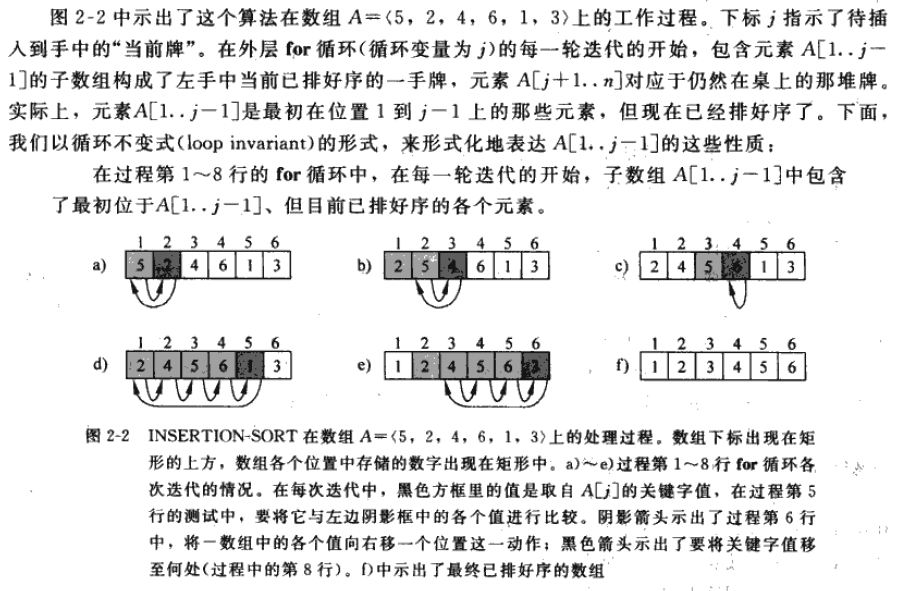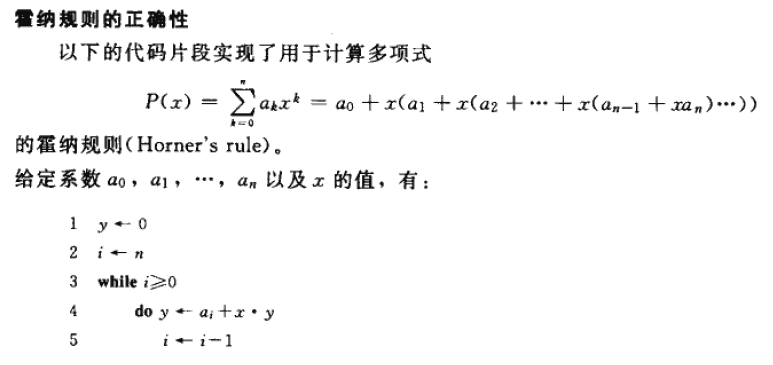插入排序法的时间复杂度为n的平方,对于较小的输入规模来说,插入排序法比合并排序法更快些。在最佳情况下,即输入数组已经排序好,则时间复杂度可表示为n,是一个线性函数;在最差情况下,即输入数组是逆序排列时,时间复杂度为 $an^2+bn+c$. 插入排序法的具体实现方法如下:

具体的c/c++语言实现如下:
c/c++语言实现:
1
2
3
4
5
6
7
8
9
10
11
12
13
14
15
16
17
18
19
20
21
22
23
24
25
26
27
28
29
30
31
32
33
34
35
36
37
38
39
40
41
42
43
44
45
46
47
48
49
50
51
52
53
54
55
56
57
58
59
60
61
62
63
64
65
66
67
68
69
70
71
72
73
74
75
76
77
78
79
80
81
82
| #include<iostream>
#include<ctime>
using namespace std;
void InsectionSortAscend(int* arrayA,int Length);
void InsectionSortDescend(int* arrayA,int Length);
void main()
{
clock_t start,finish;
double totaltime;
start=clock();
int arrayA[6]={5,2,4,6,1,3};
int Length=sizeof(arrayA)/sizeof(int);
InsectionSortDescend(arrayA,Length);
InsectionSortAscend(arrayA,Length);
finish=clock();
totaltime=(double)(finish-start)/CLOCKS_PER_SEC;
cout<<"此两个程序的运行时间为"<<totaltime<<"秒!"<<endl;
}
void InsectionSortAscend(int* arrayA,int Length)
{
int i=0;
int j=0;
int temp=0;
for(i=1;i<Length;i++)
{
temp=arrayA[i];
j=i-1;
while(j>=0&&arrayA[j]>temp)
{
arrayA[j+1]=arrayA[j];
j=j-1;
}
arrayA[j+1]=temp;
}
for(int i=0;i<Length;i++)
cout<<arrayA[i];
cout<<endl;
}
void InsectionSortDescend(int* arrayA,int Length)
{
int i=0;
int j=0;
int temp=0;
for(i=Length-2;i>=0;i--)
{
temp=arrayA[i];
j=i+1;
while(j<Length&&arrayA[j]>temp)
{
arrayA[j-1]=arrayA[j];
j=j+1;
}
arrayA[j-1]=temp;
}
for(int i=0;i<Length;i++)
cout<<arrayA[i];
cout<<endl;
}
|
注意:我是在vs2008上运行的,与vc 6.0有点区别,主要是循环体中的循环变量的作用域,出错体现在循环变量的重复定义上。例如:在vs2008或vs2010上 (现在都已经VS2019啦!— tengweitw于2020年07月24日),程序为:
#include
void main()
{
int i=0;
for(int i=0;i<5;i++)
printf(“%d “,i);
}
则在VC 6.0上需改为:
#include
void main()
{
int i=0;
for(i=0;i<5;i++)
printf(“%d “,i);
}
排序法除了上述所说的之外还有大家都经常用的冒泡排序法,其时间复杂度为 $n$ 的平方。在这里我就不具体介绍了 (其实,后面也介绍了,哈哈哈! — tengweitw于2020年07月24日)。
(我也不清楚,当初为什么加了下面这一段,难道是为了凑字数?— tengweitw于2020年07月24日)
下面简单介绍一下如何高效的计算多项式:




